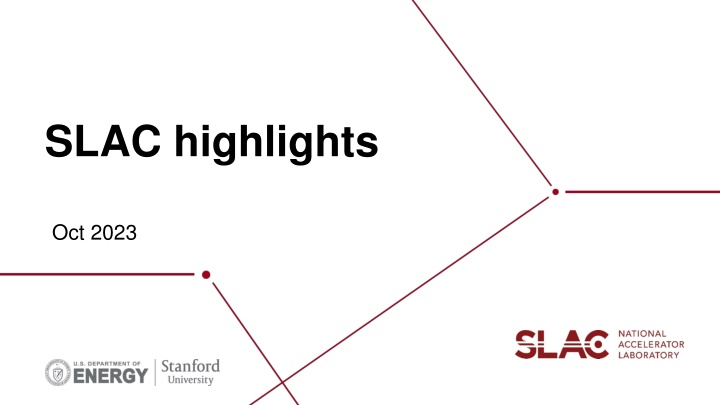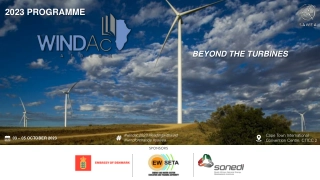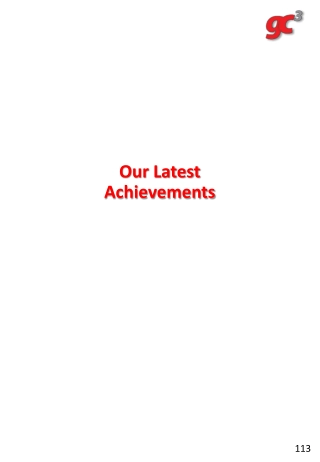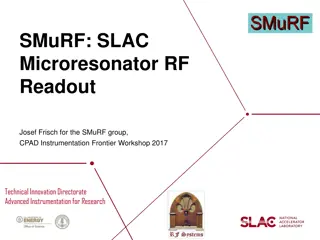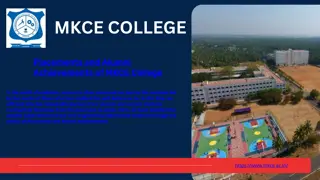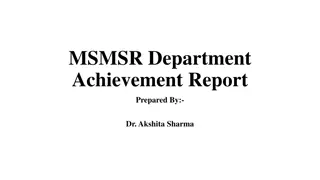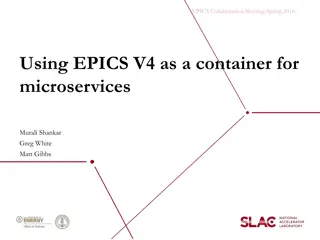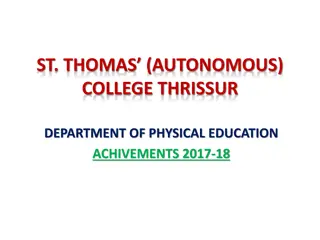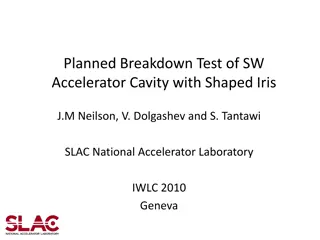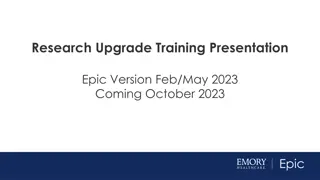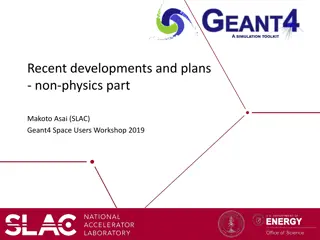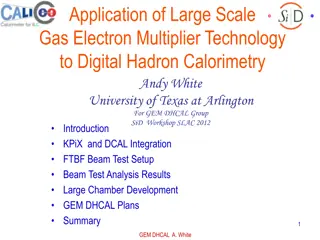Latest Achievements at SLAC - October 2023
SLAC has achieved significant milestones including first light from the SXR and HXR undulators, advancements in accelerator technology, and notable performance metrics for their FEL systems. Special thanks were extended to the LCLS-II collaboration for their hard work. The high repetition rate at LCLS-II was successfully set and tested, showcasing stable beams and pulse spacing measurements. These highlights highlight the cutting-edge research and developments at SLAC as of October 2023.
Download Presentation

Please find below an Image/Link to download the presentation.
The content on the website is provided AS IS for your information and personal use only. It may not be sold, licensed, or shared on other websites without obtaining consent from the author.If you encounter any issues during the download, it is possible that the publisher has removed the file from their server.
You are allowed to download the files provided on this website for personal or commercial use, subject to the condition that they are used lawfully. All files are the property of their respective owners.
The content on the website is provided AS IS for your information and personal use only. It may not be sold, licensed, or shared on other websites without obtaining consent from the author.
E N D
Presentation Transcript
SLAC highlights Oct 2023
LCLS-II First Light from SC Linac SXR Undulator lasing achieved on 8/23/23 HXR Undulator followed on 9/6/23 LLRF23 - SLAC Lab Highlights A. Benwell Monday PM 2
Special thanks to the entire LCLS-II collaboration for all their hard work to make this possible!
SRF Accelerator Overview LLRF23 - SLAC Lab Highlights 4
SRF Accelerator Overview RF Photocathode Gun 35 1.3 GHz Cryomodules 2 3.9 GHz Cryomodules Photocathode Gun 750 keV electrons LLRF23 - SLAC Lab Highlights 5
Relevant Performance Metrics Threshold (5 kW beam) Final objective (120 kW beam) Performance Measure Measurements Variable gap undulators 2 (soft and hard x-ray) 2 (soft and hard x-ray) Superconducting linac-based FEL system Spectrometer bend (magnet strength, screen) BPM s, laser rate Toroid, Faraday cup Superconducting linac electron beam energy 3.5 GeV 4 GeV Electron bunch repetition rate Superconducting linac charge per bunch 93 kHz 0.02 nC 929 kHz 0.1 nC Photon beam energy range 250 3,800 eV Absorption edges, spectrometer 200 5,000 eV High repetition rate capable end stations 1 N/A 2 5x108 (10x spontaneous) @2,500 eV Gas energy monitor, GMD, Spectrometer FEL photon quantity (10-3BW) per bunch > 1011@ 3,800 eV Normal conducting linac-based system Spectrometer bend (magnet strength, screen) BPM s, laser rate Toroid, Faraday cup Normal conducting linac electron beam energy 13.6 GeV 15 GeV Electron bunch repetition rate Normal conducting linac charge per bunch 120 Hz 0.1 nC 120 Hz 0.25 nC Photon beam energy range 1 15 keV 1 25k eV Absorption edges, spectrometer Low repetition rate capable end stations 2 3 N/A Gas energy monitor, GMD, Spectrometer FEL photon quantity (10-3BWa) per bunch 1010(lasing @ 15 keV) > 1012@ 15 keV LLRF23 - SLAC Lab Highlights 6
LCLS-II High Rep Rate Repetition rate is set in the control system and verified by the last BPM prior to the beam dump Repetition rate was ramped up to 93 kHz on 6/7 for the first time Subsequent measurements were carried out at half the rate but at same beam power for additional testing Pulse Spacing Measurement on Last BPM Spacing of ~10.7 s between pulses demonstrates 93 kHZ LLRF23 - SLAC Lab Highlights 7
3.5 GeV Beam 1. Stable 3 GeV beam to BSY achieved on 10/28/22 Total Cavity Voltage 2. Stable 3.5 GeV beam (on crest) to BSY achieved on 11/8/22 2 3 5 1 4 Ran stably through end of November 3. 3.5 GeV beam with L1 and L2 at nominal phase (off crest) at end of November 4. Lowered to 3 GeV for remaining beam tasks until December break 5. Following restart in May 2023, 3.5 GeV beam has been used exclusively LLRF23 - SLAC Lab Highlights A. Benwell Monday PM 8
LCLS-II LLRF System Overview Hardware/Firmware Interlock processing Software Precision Receiver Chassis (PRC) - Exclusively for cavity signals - Fiber communication for high Isolation necessary for 0.01 /0.01% RF Station (RFS) Automated Scripting - Cavity and SSA characterization Smooth transition between modes Channel Access EPICS Generates independent RF signal for 2 cavities Forward, Reverse and SSA Drive signals Detune frequency calculation, PI loop control Resonance Control All control displays and waveform readouts Cavity control interface Modes of Operation Hardware health 7 kW Piezo Tuner Control Stepper Motor Control Temperature Monitoring LCLS-II-HE will have only minor LLRF system changes LLRF23 - SLAC Lab Highlights 9
LCLS-II LLRF Hardware Resonance Control Coupler/Stepper Temperature Stepper tuner Power driver FMC Breakout Piezo tuner drivers (x4) Digital Carrier (FPGA) Fiber links RF Station Down Converter Power Board Digitizer Digital Carrier (FPGA) Up Converter LLRF23 - SLAC Lab Highlights 10 10
RF Cavity Setup & Control 4-Step Process 1.SSA calibration 2.Chirp detune scan a)Immediately find cavity and enter in SEL mode b)Enable piezo tuner response to center cavity at nominal frequency 3.Pulsed SEL calibration a)Measures loaded Q of cavity b)Calculates cavity scale factor, based on energy integration 4.Set to target field in SELAP mode * Some user interfaces have been updated in production Cavity Forward Reverse LLRF23 - SLAC Lab Highlights 11
LCLS-II High Energy Upgrade Project 1. Install 23 additional cryomodules (L4 Linac) to increase the LCLS-II accelerator energy to 8 GeV. 2. Install new cryogenic distribution system between Cryoplant-2 and the new L4 Linac. 3. Upgrade soft X-ray undulator for 8 GeV operation. 4. Upgrade the X-ray Pump Probe (XPP) instrument for MHz beam and data rates and upgrade the photon transport optics and beamline components through the Hard X-ray instruments. 5. For extended hard X-ray performance, develop conceptual design of a Low-Emittance Injector (LEI) including a tunnel design to support its construction. Also fund construction of a prototype high gradient SRF gun (30 MV/m cathode field) for the LEI. LLRF23 - SLAC Lab Highlights A. Benwell Monday PM 12 12
LCLS-II-HE Project Goals LLRF23 - SLAC Lab Highlights 13
LCLS-II-HR RF System Overview Section # of CM # of Cavities Minimum Gradient [MV/m] QL SSA Power [KW] L0 1 8 16.3 4.1e7 3.8 L1 2 16 13.6 4.1e7 3.8 L2 12 96 3.8 15.5 -> 16 4.1e7->6.0e7 L3 20 160 3.8 15.5 -> 16 4.1e7->6.0e7 L4 23 184 20.8 6.0e7 7.0 No major changes to RF control, but LLRF system must regulate higher gradient with higher loaded Q RF regulation at > 0.1 Hz remains the same - 0.01 RMS in phase - 0.01% RMS in amplitude RF regulation assumes - < 1% beam current fluctuation - < 10 Hz microphonic detuning Resonance Control regulation - Piezo tuner setting accuracy < 1Hz HE Linac changes L2 and L3 gradient increased L2 and L3 cavity QL increased L4 new, with increased gradient LLRF23 - SLAC Lab Highlights 14 14
Variational autoencoders for noise reduction in industrial LLRF systems Industrial systems are becoming increasingly complex this increases the need for automation and more sophisticated control systems Comparison of noise reduction on RF signals of a simulated room temperature s-band system, using feedforward autoencoder, convolutional networks, variational recurrent autoencoder, and Kalman filters J. Edelen Tue. AM LLRF23 - SLAC Lab Highlights 15
SRF cavity field and resonance controller based on DMD Initial Results Motivation: Decrease RF power consumption, cryogenic heat loads and costs by minimizing SRF cavity detuning due to microphonics Goal: Enhance SRF cavity stability and minimize SRF cavity detuning with a data-driven Model Predictive Control (MPC) based on the Dynamic Mode Decomposition (DMD) method The MDM model and the MPC controller have been validated with simulations. Results are promising implementing the controller in a LCLS-II LLRF system. Collected RF and piezo waveforms from LCLS-II cavities, under specific conditions, to train the DMD model, and the prediction error is less than 3% Implementing the MPC on an FPGA of the resonance control chassis of the LCLS-II LLRF system LLRF23 - SLAC Lab Highlights 16 J. Diaz Wed. AM
S-BAND TRANVERSE DEFLECTOR SYSTEM FOR LCLS-II The S-band Transverse Deflector (STCAV2) is a 2856 MHz deflecting cavity used for longitudinal beam diagnostics, such as, absolute electron bunch length, slice energy spread, and vertical slice emittance The ATCA-based LLRF system consists of two advanced mezzanine cards (AMC cards) into a carrier with an FPGA for all signal processing, timing/triggers, interface to RTM and EPICS 370 MS/s ADCs and DACs LLRF23 - SLAC Lab Highlights N. Ludlow Poster 17
Other Activities FW/SW Framework for SRF control CI/CD pipeline for testing and deploying the FPGA FW and embedded SW for the AMD Xilinx MicroBlaze processor First application is the ML based active resonance control system for LCLS-II cavities M. Donna Poster Drift correction and compensation in LCLS-II S. Murthy Talk Monday PM SRF gun development for new low emittance injector RF based synchronization for LCLS complex Not presented here LLRF23 - SLAC Lab Highlights 18
Thank you LLRF23 - SLAC Lab Highlights 19
